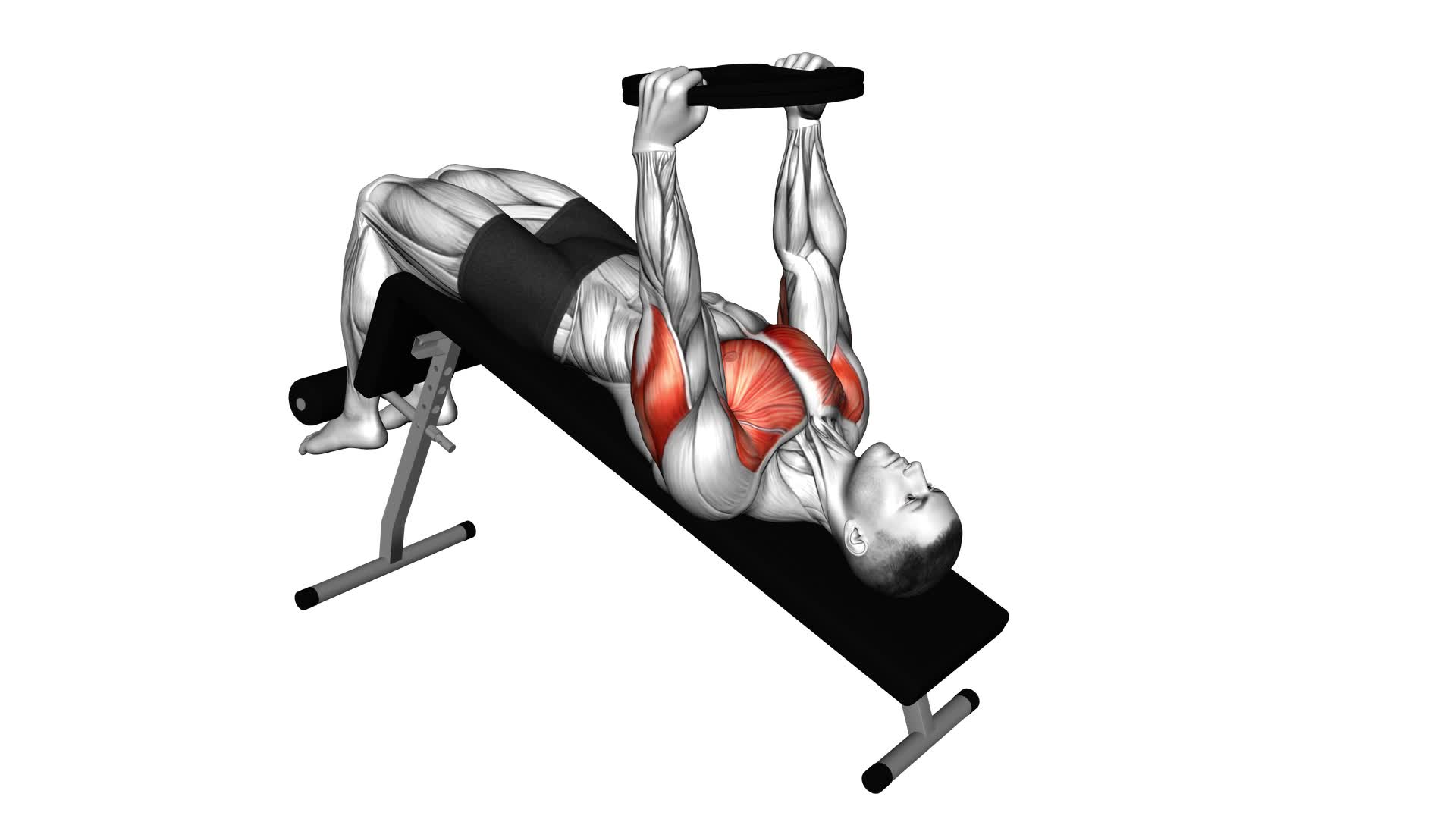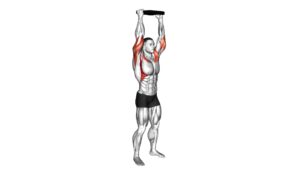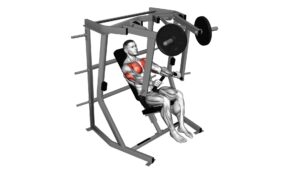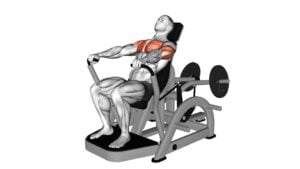Weighted Plate Decline Chest Press (male) – Video Exercise Guide & Tips

Are you looking to take your chest workout to the next level? Then the weighted plate decline chest press is the perfect exercise for you.
Watch This Exercise Video
In this video exercise guide, you'll learn the proper form and technique to maximize your results.
With variations and modifications available, you can tailor this exercise to your specific fitness level.
Avoid common mistakes and get ready to see impressive gains with this challenging chest press.
Let's get started!
Key Takeaways
- Weighted Plate Decline Chest Press increases upper body strength and muscle hypertrophy
- The exercise targets the chest, shoulders, and triceps, with additional activation of the lower chest muscles due to the decline angle.
- Proper form and technique, including maintaining core engagement and breathing technique, are essential for maximizing results and preventing injuries.
- Experimenting with different equipment variations and gradually increasing weights can help progress and avoid compromising form.
Benefits of Weighted Plate Decline Chest Press
You will experience significant gains in upper body strength and muscle hypertrophy by incorporating weighted plate decline chest press into your workout routine. This exercise specifically targets the muscles in your chest, shoulders, and triceps, helping to develop a strong and well-defined upper body. The decline angle of the bench increases the activation of the lower chest muscles, allowing for a greater range of motion and increased muscle recruitment.
One of the key benefits of the weighted plate decline chest press is its ability to stimulate muscle growth. By adding resistance in the form of weighted plates, you're increasing the intensity of the exercise, leading to greater muscle hypertrophy. This exercise also helps to improve muscular endurance, as you're required to perform multiple repetitions with a challenging load.
Another benefit of the weighted plate decline chest press is its versatility. There are several variations of this exercise that can be incorporated into your routine to target different areas of the chest. For example, you can adjust the angle of the bench to target the upper chest or focus on the inner or outer chest by adjusting your hand position. Additionally, you can vary the grip width to further emphasize different muscle groups.
Incorporating the weighted plate decline chest press into your workout routine can provide numerous benefits for upper body strength and muscle hypertrophy. By adjusting the angle and grip width, you can target different areas of the chest and achieve a well-rounded upper body development.
Equipment and Setup for Weighted Plate Decline Chest Press
To properly set up for the weighted plate decline chest press, gather the necessary equipment and position yourself on a decline bench.
Here is a step-by-step guide to ensure a proper equipment setup and maximize muscle activation:
- Equipment Setup:
- Decline Bench: Adjust the decline bench to a suitable angle, typically between 15 to 30 degrees, to target the lower chest muscles effectively.
- Weighted Plates: Choose the appropriate weight and secure them onto the barbell or dumbbells.
- Barbell or Dumbbells: Select the equipment that you're comfortable with and can handle the desired weight.
- Body Positioning:
- Lie on the decline bench with your feet firmly placed on the footrests or floor for stability.
- Grip the barbell or dumbbells with an overhand grip, slightly wider than shoulder-width apart.
- Position the barbell or dumbbells directly above your chest, with your arms fully extended.
- Muscle Activation:
- Engage your core muscles by pulling your belly button towards your spine.
- Lower the barbell or dumbbells towards your lower chest, keeping your elbows slightly flared out.
- Push the weight back up to the starting position, fully extending your arms.
Proper Form and Technique for Weighted Plate Decline Chest Press
For optimal muscle activation during the weighted plate decline chest press, focus on maintaining proper form and technique. This exercise primarily targets the chest muscles, including the pectoralis major and minor, as well as the triceps and anterior deltoids. To perform the exercise correctly, lie on a decline bench with your feet secured and your knees bent at a 90-degree angle. Hold a weighted plate with both hands, positioning it at your chest level. Engage your core and press the plate upward, extending your arms fully. Lower the plate back down to your chest in a controlled manner. Remember to keep your elbows slightly bent throughout the movement to avoid excessive strain on the joints. It's important to maintain proper breathing throughout the exercise, exhaling as you press the weight up and inhaling as you lower it down.
There are several benefits to incorporating the weighted plate decline chest press into your workout routine. It not only strengthens your chest muscles but also helps improve upper body strength and stability. Additionally, it can enhance your overall pressing strength and promote better muscular balance.
Variations of the weighted plate decline chest press can be performed using different equipment, such as dumbbells or a barbell. These variations provide additional challenges and target different muscle fibers. Experimenting with different equipment and variations can help keep your workouts interesting and prevent plateauing. Remember to start with lighter weights and gradually increase the load as you become more comfortable with the exercise. Always prioritize safety and proper form to maximize the effectiveness of your workout.
Variations and Modifications for Weighted Plate Decline Chest Press
One way to modify the weighted plate decline chest press is by using different types of equipment. Here are three variations and modifications you can try to target your chest muscles more effectively:
- Dumbbell Decline Chest Press: Instead of using a weighted plate, you can use dumbbells. Lie on a decline bench and hold a dumbbell in each hand, with your palms facing forward. Push the dumbbells up and away from your chest, bringing them close together at the top and then slowly lower them back down to the starting position.
- Resistance Band Decline Chest Press: Attach a resistance band to the bottom of the decline bench and hold the handles in each hand while lying down. Push the handles away from your chest, extending your arms fully, and then slowly bring them back towards your chest.
- Barbell Decline Chest Press: Lie on a decline bench and hold a barbell with an overhand grip, hands slightly wider than shoulder-width apart. Lower the barbell towards your chest, keeping your elbows slightly tucked in, and then press it back up to the starting position.
By incorporating these variations and modifications into your workout routine, you can add variety and challenge your chest muscles in different ways.
Now, let's move on to the next section and discuss some common mistakes to avoid during the weighted plate decline chest press.
Common Mistakes to Avoid During Weighted Plate Decline Chest Press
When performing the weighted plate decline chest press, it's important to pay attention to your elbow positioning. Keep your elbows tucked in and pointing slightly downward to target your chest muscles effectively.
Additionally, make sure to maintain proper breathing technique throughout the exercise, exhaling as you push the weight up and inhaling as you lower it down.
Lastly, focus on maintaining core stability by engaging your abdominal muscles and avoiding excessive arching of your back.
Elbow Positioning Importance
To achieve optimal results during the Weighted Plate Decline Chest Press, it's crucial that you maintain proper elbow positioning to avoid common mistakes. Correct elbow positioning is essential for maximizing muscle activation and preventing injury.
Here are three reasons why elbow positioning is important:
- Muscle Activation: When your elbows are positioned correctly, it allows for better activation of the chest muscles, specifically the pectoralis major. This ensures that you're effectively targeting the intended muscle group and getting the most out of your workout.
- Stability and Control: Proper elbow positioning provides stability and control throughout the exercise. It helps to stabilize the weight and prevents unnecessary strain on the shoulders and elbows, reducing the risk of injury.
- Range of Motion: Maintaining a proper elbow position allows for a full range of motion during the exercise. This enables you to fully extend and contract the chest muscles, leading to improved strength and muscle development.
Proper Breathing Technique
Maintain proper breathing technique to optimize your Weighted Plate Decline Chest Press and avoid common mistakes.
Proper breathing during this exercise is crucial for maximizing your performance and minimizing the risk of injury. One effective breathing exercise to practice is diaphragmatic breathing. This technique involves taking deep breaths into your diaphragm, rather than shallow breaths into your chest.
When performing the Weighted Plate Decline Chest Press, exhale as you push the weight away from your body and inhale as you bring the weight back towards your chest. This rhythmic breathing pattern helps stabilize your core and provide the necessary oxygen to your muscles.
Remember to focus on your breath and avoid holding your breath, as it can increase your blood pressure and lead to dizziness or lightheadedness.
Core Stability During Exercise
What is the importance of maintaining proper core stability during the Weighted Plate Decline Chest Press exercise?
Core stability plays a crucial role in performing the Weighted Plate Decline Chest Press safely and effectively. By engaging your core muscles, you can enhance your overall stability and prevent any potential injuries.
Here are three reasons why maintaining core stability is essential during this exercise:
- Stabilization muscles: The Weighted Plate Decline Chest Press primarily targets your chest muscles, but it also engages your core muscles as stabilizers. Keeping your core stable helps maintain proper form and prevents excessive strain on your lower back.
- Improved balance: Core engagement during the exercise promotes better balance, allowing you to perform the movement with control and precision. This helps you generate more power and maximize the benefits of the exercise.
- Injury prevention: A strong core provides a solid foundation for the movement, reducing the risk of injuries. By stabilizing your spine, core stability protects your lower back and prevents unnecessary stress on the surrounding structures.
Tips for Maximizing Your Results With Weighted Plate Decline Chest Press
To maximize your results with the weighted plate decline chest press, it's important to focus on proper form techniques and incorporate progressive overload strategies.
Ensuring that you maintain proper form throughout the exercise will target the chest muscles effectively and minimize the risk of injury.
Additionally, progressively increasing the weight or reps over time will challenge your muscles and promote strength and muscle growth.
Proper Form Techniques
You can improve your results with the Weighted Plate Decline Chest Press by focusing on proper form techniques. To maximize your gains, pay attention to core engagement and shoulder positioning. Here are three key tips to help you optimize your workout:
- Engage your core: Before you start the exercise, activate your core muscles by drawing your belly button towards your spine. This will provide stability and prevent excessive arching of the lower back.
- Maintain proper shoulder positioning: Keep your shoulders down and back throughout the movement. Avoid shrugging or rounding your shoulders forward, as this can place unnecessary strain on the neck and upper back.
- Control the descent and ascent: Slowly lower the weights towards your chest while maintaining control and stability. Then, press the weights back up explosively, focusing on using your chest muscles to drive the movement.
Progressive Overload Strategies
To maximize your results with the Weighted Plate Decline Chest Press, implement progressive overload strategies.
Progressive overload is a key concept in strength training that involves gradually increasing the demands placed on your muscles to stimulate growth and adaptation. There are several progressive overload techniques you can use with the Weighted Plate Decline Chest Press to continually challenge your muscles and promote gains in strength and size.
One effective technique is to gradually increase the weight you lift over time. Start with a weight that allows you to perform the exercise with proper form and gradually add more weight as you become stronger.
Another technique is to increase the number of sets and repetitions you perform. This can be done by adding an extra set or two each week or by increasing the number of repetitions in each set.
It's also important to program your workouts for progressive overload. This means gradually increasing the intensity and difficulty of your workouts over time. You can do this by increasing the weight, adding more sets and repetitions, or reducing rest time between sets.
Frequently Asked Questions
How Many Sets and Reps Should I Do for the Weighted Plate Decline Chest Press?
For the weighted plate decline chest press, it's important to find the optimal weight for your fitness level. Start with a weight that challenges you but allows you to maintain proper form. Aim for 3-4 sets of 8-12 reps, resting for about 60 seconds between sets.
As you progress, gradually increase the weight to continue challenging your muscles. Remember, there are variations and modifications available for different fitness levels, so consult with a fitness professional for personalized guidance.
Can Women Also Perform the Weighted Plate Decline Chest Press Exercise?
Yes, women can definitely perform the weighted plate decline chest press exercise.
It offers several benefits for women, such as strengthening the chest, shoulders, and triceps, improving overall upper body strength and muscular endurance.
Additionally, there are variations of the exercise that can be adapted to different fitness levels, allowing women to progress and challenge themselves as they get stronger.
It's a great addition to any workout routine for women looking to tone and sculpt their upper body.
Is It Necessary to Use a Decline Bench for This Exercise or Can I Do It on a Regular Flat Bench?
To get the most out of the weighted plate decline chest press, it's recommended to use a decline bench. This position targets the lower chest muscles more effectively and helps increase muscle activation.
However, if you don't have a decline bench, you can still perform this exercise on a regular flat bench. Just keep in mind that the angle won't be as steep, so the emphasis on the lower chest may not be as pronounced.
What Muscles Does the Weighted Plate Decline Chest Press Primarily Target?
The weighted plate decline chest press primarily targets the muscles in your chest, specifically the pectoralis major and minor. It also engages the triceps and shoulders to a lesser extent.
Variations of the decline chest press include using dumbbells or a barbell instead of weighted plates. These variations can offer different angles and levels of resistance, allowing you to target your chest muscles in slightly different ways.
Can I Use Dumbbells Instead of a Weighted Plate for This Exercise?
Yes, you can definitely use dumbbells instead of a weighted plate for the decline chest press.
It's important to maintain proper form to get the most out of the exercise.
Lie on a decline bench, holding the dumbbells with an overhand grip.
Lower the dumbbells slowly towards your chest, then push them back up to the starting position.
Keep your back and feet firmly planted on the bench for stability.
Conclusion
In conclusion, the weighted plate decline chest press is an effective exercise for targeting and strengthening the chest muscles. By using proper form and technique, individuals can maximize their results and avoid common mistakes.
Variations and modifications can be made to cater to different fitness levels and goals. With the right equipment and setup, this exercise can be a valuable addition to any workout routine.

Author
Years ago, the spark of my life’s passion ignited in my mind the moment I stepped into the local gym for the first time. The inaugural bead of perspiration, the initial endeavor, the very first surge of endorphins, and a sense of pride that washed over me post-workout marked the beginning of my deep-seated interest in strength sports, fitness, and sports nutrition. This very curiosity blossomed rapidly into a profound fascination, propelling me to earn a Master’s degree in Physical Education from the Academy of Physical Education in Krakow, followed by a Sports Manager diploma from the Jagiellonian University. My journey of growth led me to gain more specialized qualifications, such as being a certified personal trainer with a focus on sports dietetics, a lifeguard, and an instructor for wellness and corrective gymnastics. Theoretical knowledge paired seamlessly with practical experience, reinforcing my belief that the transformation of individuals under my guidance was also a reflection of my personal growth. This belief holds true even today. Each day, I strive to push the boundaries and explore new realms. These realms gently elevate me to greater heights. The unique combination of passion for my field and the continuous quest for growth fuels my drive to break new ground.







